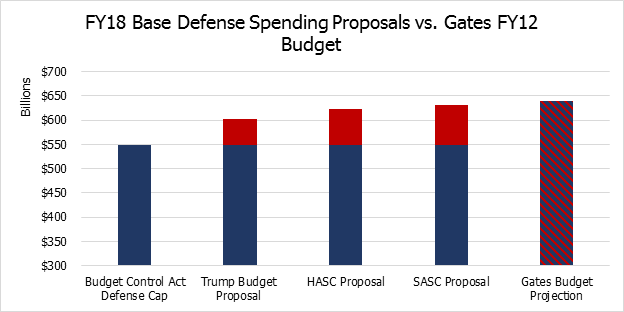Defense Bill on Collision Course with Reality
Defense spending will soon return to the legislative forefront as the Senate readies for debate on the Fiscal Year 2018 National Defense Authorization Act (NDAA) next month after the bill’s unanimous and bipartisan passage through the Senate Armed Services Committee. The House of Representatives has passed its version of the NDAA by an overwhelming margin. As both bills increase allocations for defense, one might conclude that a major increase in defense spending seems inevitable.
The reality of the budget spending caps (sequester caps) still holds defense spending increases hostage. Since FY 2018 appropriations bills are expected to pass Congress well after the October 1 start of the new fiscal year, defense spending will remain at the previous year’s appropriated levels until the new spending legislation is approved.
Senate vs. House NDAA
Both bills, in their current form, represent significant departures from last year’s benchmark of defense funding. The Senate bill proposes $632 billion in base discretionary defense funding, while the House bill proposes a $623.8 billion ? both nearly 20% higher than last year’s funding level. Further, both bills provide significant authorizations for Overseas Contingency Operations (OCO) in addition to the base funding levels, which bring the proposed total defense spending levels up to $700 billion and $688 billion for the Senate and House respectively. These proposed increases in funding may seem drastic upon first glance. Indeed, total defense levels would increase by about $100 billion, or 20 percent, in one year. But consider the context.
Over the last six years, since the passage of the economically and institutionally destructive Budget Control Act caps, defense spending has been cut by nearly a trillion dollars relative to its projected FY 2018 level (as projected in the FY 2012 “Gates Budget”, the last budget which made defense spending projections before the Budget Control Act passed). The graphic below shows the FY 2018 Defense spending proposals in comparison to both the Budget Control Act cap, and the FY 2012 budget project made by then Defense Secretary Robert Gates. It’s notable that when Gates made his assessment for FY 2012, he stated that the funding levels he prescribed were the “minimum necessary.”

Sources: CBO, OMB, HASC, SASC, DoD. Note: Bars extend down to $0.
Current and former Secretaries of Defense, as well as the Joint Chiefs of Staff, have all echoed the same conclusion: the Budget Control Act caps have done palpable harm to U.S. military readiness. As General Joseph Dunford said in a congressional hearing in June, “without sustained, sufficient, and predictable funding I assess that within 5 years we will lose our ability to project power; the basis of how we defend the homeland, advance U.S. interests, and meet our alliance commitments.”
Political Reality
Even given General Dunford’s dire prediction, it is unlikely that either the Senate or House NDAA increases will become law. As it stands, any new additional appropriations for defense would have to be reallocated from the nondefense discretionary budget, due to the Budget Control Act caps. Democrats, and some Republicans, are unlikely to support such reallocations.
This means that the only way to enact either the House or Senate versions of the NDAA in their current form would be to repeal the Budget Control Act. A repeal would necessarily require Democratic votes in the Senate because changes to the Budget Control Act caps require 60 votes.
Unfortunately, it is far more likely that such a “grand bargain,” in which Republicans would negotiate with Democrats to repeal the Budget Control Act, will fail as it has in the past. Then the only remaining options would be a slightly modified “small-deal” FY 2018 Budget Resolution, with no significant increases in funding for either defense or nondefense discretionary, or a Continuing Resolution with no changes at all. In fact, a continuing resolution would actually trigger slight spending cuts for defense, as the Budget Control Act spending caps for FY18 are slightly lower than last years spending levels.
Alongside growing angst about increasing the nation’s statutory debt limit and major efforts for significant tax reform, trying to pass either a FY 2018 Budget Resolution or higher levels of defense spending in the appropriations bills may simply fall to the wayside of the legislative logjam in September. In any case, getting defense spending back on track will take bipartisan leadership.
As Senate Armed Services Committee Chairman John McCain put it in a recent floor speech: “What have we to lose by trying to work together to find those solutions? We’re not getting much done apart?There’s greater satisfaction in respecting our differences, but not letting them prevent agreements that don’t require abandonment of core principles, agreements made in good faith that help improve lives and protect the American people.”
Share
Read Next
Support Research Like This
With your support, BPC can continue to fund important research like this by combining the best ideas from both parties to promote health, security, and opportunity for all Americans.
Give NowRelated Articles
Join Our Mailing List
BPC drives principled and politically viable policy solutions through the power of rigorous analysis, painstaking negotiation, and aggressive advocacy.